Do You Know the Soroptimist Club? (No.18)
The difficulty for foreign companies operating in Belgium is the high labour cost. The labour-intensive industries in particular are compelled to reflect the high labour cost in the product price, which means that in the price competition with cheaper imports from developing countries, they stand at a catastrophic disadvantage. So, how high are the wages in the manufacturing industry in Belgium compared with other countries? The average amount in 2012 is 37 euro per hour, which is a surprise indeed. By the way, the average hourly wage in Japan is 27, 46 euro. That is slightly below average in the developed world. The average hourly wage in France is 25 % higher than in Japan and in Germany it is 10% higher than in Japan. The average hourly wage in the UK and the US is 15% to 20% lower than in Japan. In developed countries as well, wage levels are lower in those countries with a large influx of cheap labour from the developing countries. The wage levels in the manufacturing industry in Belgium are undoubtedly amongst the highest in the world, but the employer’s social security contributions amounting to 27% are included and because the levied income tax on the employees’ wages is high as well, the net income of the Belgians is surprisingly low. I guess that Sweden with statistically the highest wage levels and Denmark with the second highest wage levels are in the same situation.
< Subsequent Visits to Local Heads >
Last week I visited East Flanders and met with two Vice Governors, Mr Alexander Vercamer and Mr Geert Versnick. I could not meet Governor Jan Briers because of circumstances: while he was very busy dealing with the aftermath of the recent train accident, the former governor passed away the day before our meeting. East Flanders is a rich province with 1.430.000 inhabitants and home to two ports, the Port of Ghent and the Port of Antwerp (West Bank). The province is involved with more than 90 % of the export to Japan. 2039 Japanese tourists (2012) stayed over in Ghent and other cities in East Flanders, but the peak was reached 4 years ago (3506 Japanese tourists) and tends to decrease. The provincial authorities would like to shift towards logistics taking advantage of waterways and railways rather than land transport in view of economic revitalization. I requested them to continue to support the nearly 20 Japanese companies that are operating in the province.
On the same day, I visited the third largest city of East Flanders, Sint-Niklaas (73.000 inhabitants) where I had lunch with the mayor, Mr Lieven Dehandschutter. The first task of the new mayor who just took office this January is to restore the public finances to health and he is implementing a budget cut of 5%. Also, the shopping district in the city has been deserted due to the arrival of big out-of-town stores. Therefore, the revitalization of the shopping streets is also a priority issue. In addition, they are converting the site of a factory that was forced to close in recent years into a residential area and the population of the city interestingly continues to increase. Sint-Niklaas is famous for the “Peace Festival” that takes place every year in September (20 to 25 hot air balloons take off at the main square). This event has been held for over 100 years. I was also surprised to hear that the 800 year anniversary of the city is planned in 4 years from now.
Last weekend, I met with Mr Willy Demeyer, mayor of Liège (192.500 inhabitants). He has been mayor since 1999, since 3 years he is also concurrently serving as first vice president of the Senate and he is a leading figure in the Socialist Party in Wallonia. He is very knowledgeable in history and he told me that the city hall was destroyed twice in the 15th and 17th century and rebuilt in the 18th century. He also explained that the wall decoration in the mayor’s office is designated historical heritage, although the decoration is not original, but restored. As for municipal government, his idea is to focus on the development of an economic zone with the adjacent main cities in the Netherlands and Germany and on the promotion of spin-off industries from the University of Liège. Also, in order to protect the characteristics of Liège as a historical and cultural city, he is also focusing on the protection and preservation of various heritage sites. Only few Japanese companies are active around Liège, but the mayor expressed the intention that he would like to work in close cooperation to attract more Japanese companies.
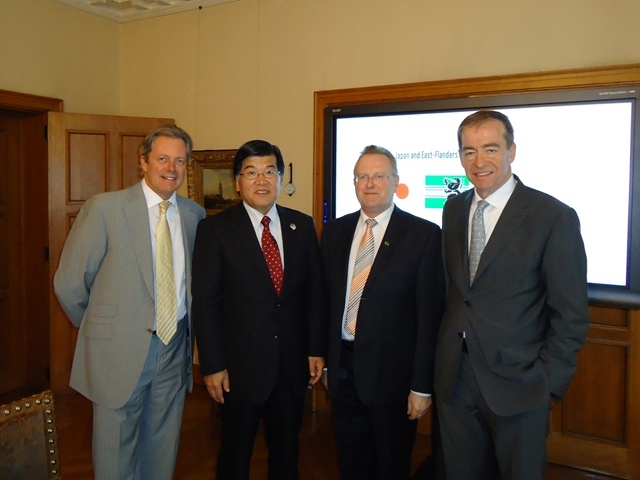 |
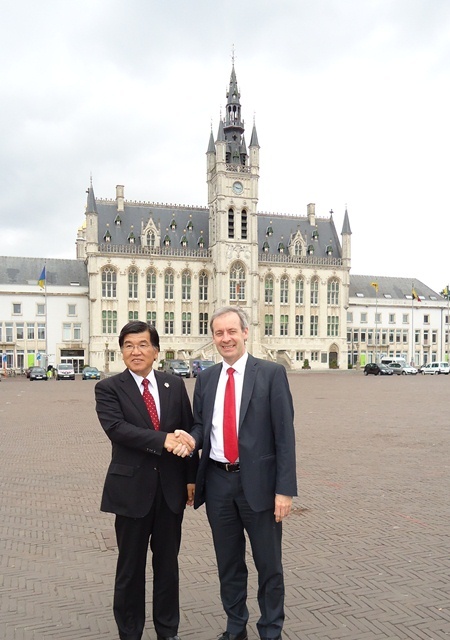 |
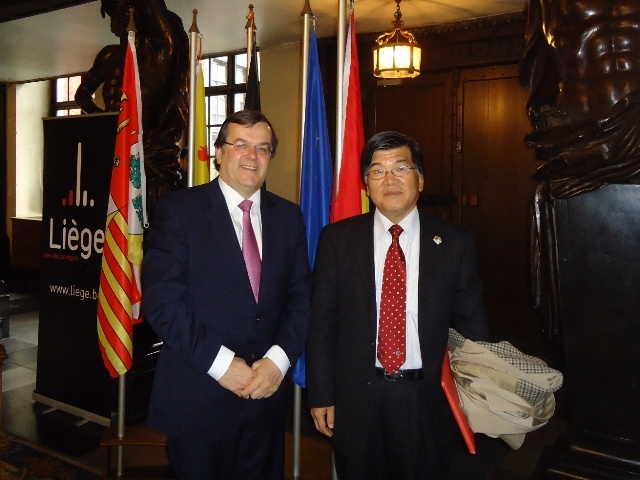 |
|
Vice Governors of East Flanders
|
Mayor of Sint-Niklaas
|
Mayor of Liège
|
< Prestigious Educational Institution in Flanders: Ghent University >
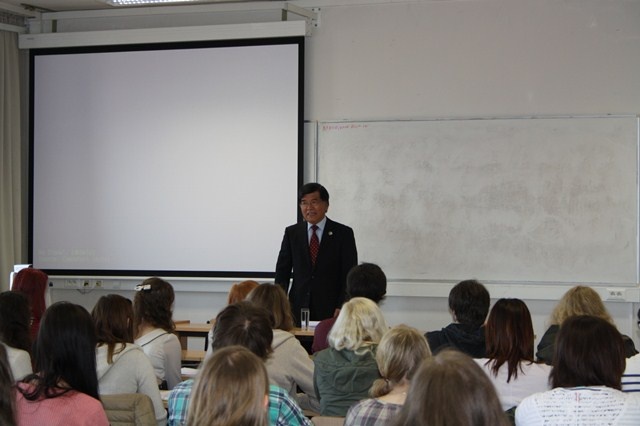 I was invited by Ghent University, located 60 km to the west of Brussels, where I had a meeting with the rector, Mr Paul Van Cauwenberghe. At the request of Professor Andreas Niehaus from the Japanese Studies Department, I also gave a lecture of about 1 hour on “Japanese Society and Culture” to 70 students of the same department. I explained that ensuring the necessary labour force for economic development is a big challenge for the Japanese society in the future while the Japanese population is decreasing due to a declining birth rate and aging population. I emphasized that efforts to bridge the gap between generations is also required. In addition, I told the students that while many countries will face a birth rate decline and an aging demographic in the latter half of the 21st century, Japan should show the world a “leading model”. However, I am not very confident that the students really understood my point. By the way, I was surprised to hear that 42 campuses of Ghent University are spread throughout the city, so there is no main campus. There are as many as 36.500 students, and characteristic for the university is the fact that one third of the students are enrolled in a master’s program. There are only 4000 foreign students (11%) and most of them are enrolled in postgraduate courses in English. In particular nearly 250 Chinese students are mainly enrolled in the Bio/Nanotechnology Department. Also, the first foreign branch campus (about 1000 students) of Ghent University was opened last month in Inchon in Korea. Against this backdrop, I felt a little sad that only 7 Japanese students study at Ghent University. I was invited by Ghent University, located 60 km to the west of Brussels, where I had a meeting with the rector, Mr Paul Van Cauwenberghe. At the request of Professor Andreas Niehaus from the Japanese Studies Department, I also gave a lecture of about 1 hour on “Japanese Society and Culture” to 70 students of the same department. I explained that ensuring the necessary labour force for economic development is a big challenge for the Japanese society in the future while the Japanese population is decreasing due to a declining birth rate and aging population. I emphasized that efforts to bridge the gap between generations is also required. In addition, I told the students that while many countries will face a birth rate decline and an aging demographic in the latter half of the 21st century, Japan should show the world a “leading model”. However, I am not very confident that the students really understood my point. By the way, I was surprised to hear that 42 campuses of Ghent University are spread throughout the city, so there is no main campus. There are as many as 36.500 students, and characteristic for the university is the fact that one third of the students are enrolled in a master’s program. There are only 4000 foreign students (11%) and most of them are enrolled in postgraduate courses in English. In particular nearly 250 Chinese students are mainly enrolled in the Bio/Nanotechnology Department. Also, the first foreign branch campus (about 1000 students) of Ghent University was opened last month in Inchon in Korea. Against this backdrop, I felt a little sad that only 7 Japanese students study at Ghent University.
< Tour of Japanese Companies >
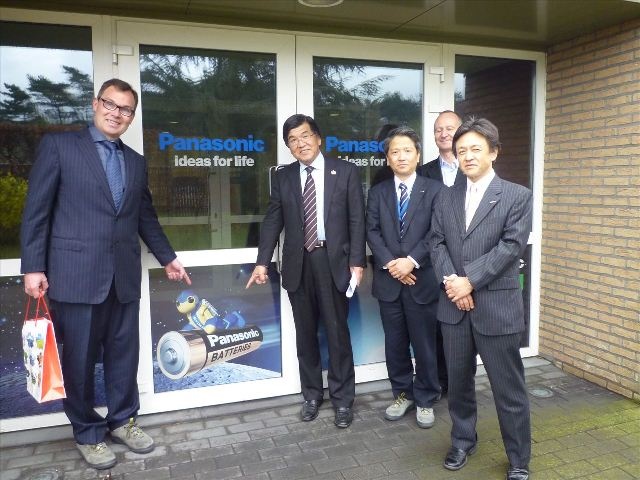 Already nearly one month ago, on the occasion of my visit to the Province of Limburg in the northeast of Belgium, I visited Panasonic Energy Belgium NV (360 employees). This company is one of the 19 factories that were expanded overseas by the Energy Device Business Department of the Panasonic Head Office in Japan. The company was founded in 1970 by the merger with the Dutch Philips and became in 2001 a wholly-owned subsidiary. As for business activities, Panasonic Energy Belgium NV is specialized in the manufacture of alkaline batteries. They produce 800 million batteries per year in a fully automated process. The sales destinations extend from all Europe to North Africa and Russia, but by delivering the goods within 5 days of receiving the order, the company has won the customers’ confidence. The market share in Europe increased to about 20-25%, but the in-house manufactured brand amounts to less than half of that share. The key to increased profitability lies in the expansion of this share. Even so, the production process of more than 1000 batteries per minute was spectacular. The number of products per employee (productivity) as well is steadily increasing every year and I hope that their business will expand further in the future. Already nearly one month ago, on the occasion of my visit to the Province of Limburg in the northeast of Belgium, I visited Panasonic Energy Belgium NV (360 employees). This company is one of the 19 factories that were expanded overseas by the Energy Device Business Department of the Panasonic Head Office in Japan. The company was founded in 1970 by the merger with the Dutch Philips and became in 2001 a wholly-owned subsidiary. As for business activities, Panasonic Energy Belgium NV is specialized in the manufacture of alkaline batteries. They produce 800 million batteries per year in a fully automated process. The sales destinations extend from all Europe to North Africa and Russia, but by delivering the goods within 5 days of receiving the order, the company has won the customers’ confidence. The market share in Europe increased to about 20-25%, but the in-house manufactured brand amounts to less than half of that share. The key to increased profitability lies in the expansion of this share. Even so, the production process of more than 1000 batteries per minute was spectacular. The number of products per employee (productivity) as well is steadily increasing every year and I hope that their business will expand further in the future.
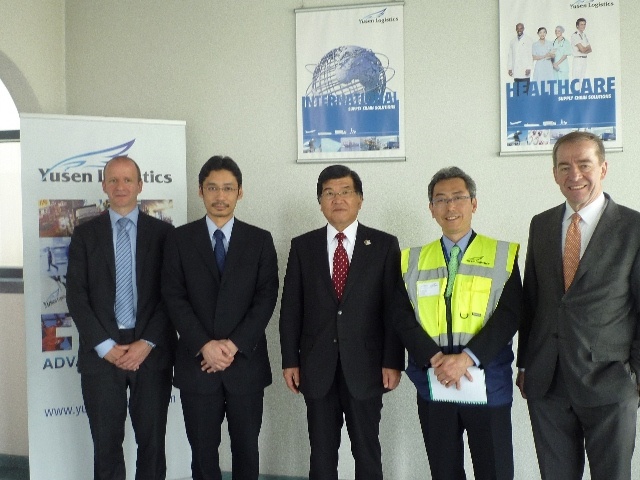 The following week, I visited Yusen Logistics Benelux, based in Ridderkerk, a district of Antwerp. The company is a sub-subsidiary of “Nippon Yusen” (established in 1885; total workforce 54.695 people) and started its activities in Belgium in 1989. However, the business scope has changed since then and the current business system has been put into place about 2 years ago. This company is not only responsible for the Benelux, but also for Sweden and 900 employees, based in 17 different warehouses, are responsible for the international distribution business. In Belgium only there are 9 warehouses and 600-650 employees, Charleroi included. The warehouse in Ridderkerk is immense, from car parts to electrical appliances and from medical equipment to general consumer goods, suggesting that they are truly handling a variety of cargo. However, at the moment, the majority of clients are related to Japanese companies, so I was told that the future challenge is to widely expand the business to Western companies as well. The following week, I visited Yusen Logistics Benelux, based in Ridderkerk, a district of Antwerp. The company is a sub-subsidiary of “Nippon Yusen” (established in 1885; total workforce 54.695 people) and started its activities in Belgium in 1989. However, the business scope has changed since then and the current business system has been put into place about 2 years ago. This company is not only responsible for the Benelux, but also for Sweden and 900 employees, based in 17 different warehouses, are responsible for the international distribution business. In Belgium only there are 9 warehouses and 600-650 employees, Charleroi included. The warehouse in Ridderkerk is immense, from car parts to electrical appliances and from medical equipment to general consumer goods, suggesting that they are truly handling a variety of cargo. However, at the moment, the majority of clients are related to Japanese companies, so I was told that the future challenge is to widely expand the business to Western companies as well.
< Greeting at the Soroptimist Club >
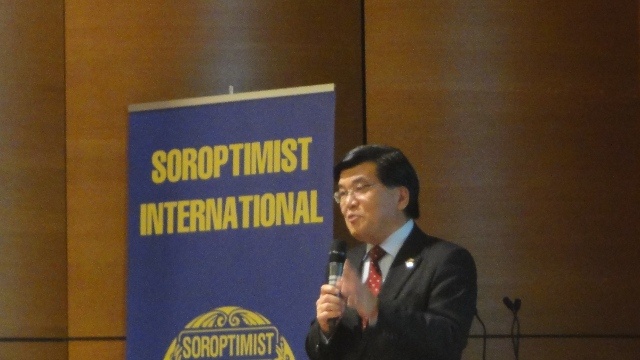 Last weekend, I attended the opening ceremony of the event for the 75th anniversary of the foundation of the Soroptimist Brussels Doyen as a guest and had the opportunity to make a greeting speech. I made a short speech in front of about 150 women, all members of the club and representatives of friendship associations and I was quite nervous about speaking at an assembly of only women. A Soroptimist Club is a “philanthropic organization of professional women” including female entrepreneurs, formed for the first time in 1921 in California in the United States. Afterwards, similar clubs were founded in various places, among which Antwerp and Brussels in Belgium as well. It’s a female version of the Rotary Club and Lions Club. At present, there are nearly 3000 clubs in more than 120 countries worldwide and the number of members amount to 95.000 people. Since the first club was founded in Japan in 1960, there are now more than 500 clubs nationwide (13.400 members). Their activities comprise, in addition to local welfare work by each club, also the promotion of international projects to support women and girls. At the time of the Great East Japan Earthquake as well, they provided an educational fund for the children affected by the disaster. Representatives of the Japanese Soroptimist “Suruga Club” attended the 75th anniversary of the foundation of the Brussels’ Club too. I think that they do not only protect the human rights of women, but they also promote economic development by improving the position of women, creating an environment in which women can be socially even more active and thus creating a society full of vigor. Soroptimist is a neologism from Latin and means “best for women” and I hope for the further development of the Soroptimist Club. Last weekend, I attended the opening ceremony of the event for the 75th anniversary of the foundation of the Soroptimist Brussels Doyen as a guest and had the opportunity to make a greeting speech. I made a short speech in front of about 150 women, all members of the club and representatives of friendship associations and I was quite nervous about speaking at an assembly of only women. A Soroptimist Club is a “philanthropic organization of professional women” including female entrepreneurs, formed for the first time in 1921 in California in the United States. Afterwards, similar clubs were founded in various places, among which Antwerp and Brussels in Belgium as well. It’s a female version of the Rotary Club and Lions Club. At present, there are nearly 3000 clubs in more than 120 countries worldwide and the number of members amount to 95.000 people. Since the first club was founded in Japan in 1960, there are now more than 500 clubs nationwide (13.400 members). Their activities comprise, in addition to local welfare work by each club, also the promotion of international projects to support women and girls. At the time of the Great East Japan Earthquake as well, they provided an educational fund for the children affected by the disaster. Representatives of the Japanese Soroptimist “Suruga Club” attended the 75th anniversary of the foundation of the Brussels’ Club too. I think that they do not only protect the human rights of women, but they also promote economic development by improving the position of women, creating an environment in which women can be socially even more active and thus creating a society full of vigor. Soroptimist is a neologism from Latin and means “best for women” and I hope for the further development of the Soroptimist Club.
|